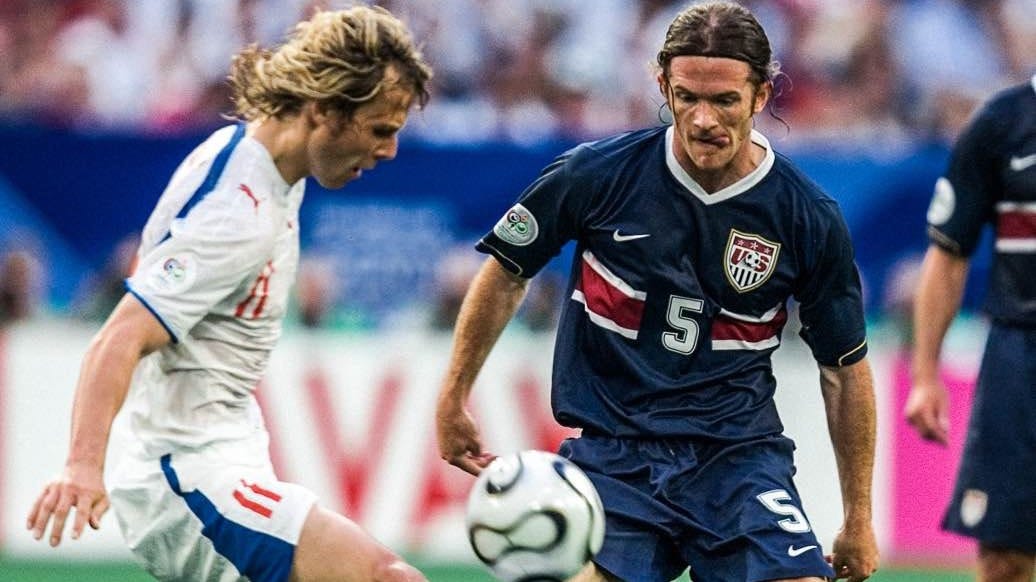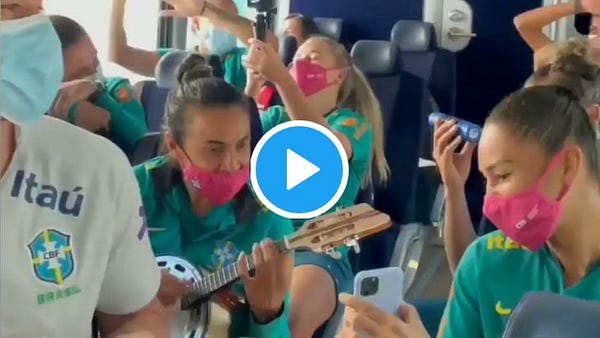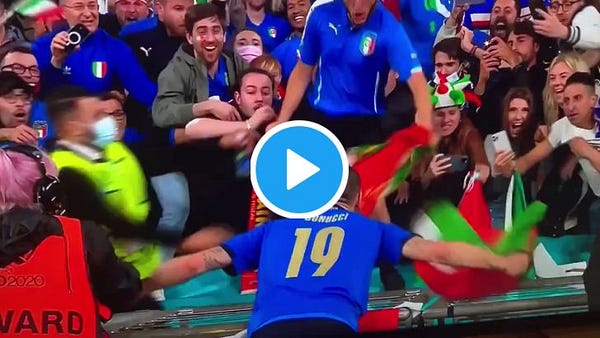John O’Brien Dreams of Soccer
Injuries ended his once-promising career at 29. He remade himself as a psychologist and a student of dreams.
In the dead of night, when he’s asleep, John O’Brien’s soccer career never ended.
His knee doesn’t hurt and he’s back on the field, with his old teammates and coaches.
He’s back to being the prodigy who left the prestigious Brentwood School in Los Angeles for the Ajax academy in Amsterdam when he was only 16. Who became one of the first Americans to establish himself as a regular with a European juggernaut. He’s still one of the breakout stars at the 2002 World Cup, a central cog in the United States men’s national team’s miraculous run to the brink of the semifinals, whom then-national team coach Bruce Arena has called “As talented a midfielder as U.S. Soccer has ever had.” He’s still the guy who made the 2006 World Cup team as well.
But even in his dreams, he worries about injuries and has conversations about them. There is no escaping the ailments that undid his career.
Curiously, O’Brien started having more dreams about soccer after he retired and moved on with his life. But by the time he had gotten a PhD in clinical psychology, he was in a position to act on them. He began studying the dreams.
There wasn’t one moment that O’Brien realized he’d played his last game as a professional at the 2006 World Cup in Germany, during the second half of the USA’s opening match against the Czech Republic. That the injury he picked up in that game would not only end his tournament but force him to reinvent himself entirely.
“It wasn’t cut and dried. It wasn’t a doctor saying, ‘Hey, you’re done playing,’” O’Brien says. “It was an accumulation and this kind of point where I was recovering again and injured again and just very uninterested in recovering and also losing hope that I could be a player that could contribute at a level that felt good, without pain and without it being a struggle.”
After the better part of eight injury-riddled seasons in the Netherlands, spent mostly with Ajax, he joined Chivas USA of Major League Soccer before the World Cup. When he returned, he never made it back onto the field before his contract ran out. The club made a lowball offer that he rejected. He thought he’d rehab on his own and get a better deal. And then he just kind of drifted away from professional soccer.
“There was still a fire burning bright for soccer, but then there was this reality that I just can’t bring myself to do this,” O’Brien says. For several years, he trained with former colleagues as they got ready for their pre-seasons. But then he’d inevitably get into other things as they began their campaigns, and he’d find himself more interested in all of the things that weren’t soccer. He played on an amateur team for a while, but the injuries wouldn’t leave him alone. When he was healthy, he felt like he could still play professionally. The next morning, he’d wake up too sore to even contemplate a future in soccer.
After all, it wasn’t just the chronic pain in his right knee. There were nagging hamstring and Achilles injuries, soft-tissue problems that kept coming back. He’d made only 10 appearances in his last four club seasons, although, strangely, he somehow played in 11 national team games in the last two years of his career.
He’d had enough. Staying on the field was impossible and getting back onto it became more trying with every fresh injury. “The effort wasn’t worth what might have come of it,” he says.
O’Brien had gone to a pricey private school in one of the toniest neighborhoods of Los Angeles, a celebrity factory that graduated Maroon 5, Jonah Hill, Fred Savage, Arnold Schwarzenegger’s children and scores of other people of renown. “It was very thoughtful, social and high-achieving academically,” O’Brien remembers. The place left him with an academic inclination and pedigree.
He hadn’t finished high school when he signed for Ajax and graduated from an international school in Amsterdam. Then, as he played in the second team, he went to a Dutch college with a management program taught in English. He took some psychology classes and enjoyed having a part of his day that didn’t revolve around soccer and, as he put it, gave him a break from his “physical, manual labor job.”
“I liked it more so than the soccer environment, where you get told not to think. ‘Just be in your body. Just perform. Don’t think too much,’” O’Brien reflects now.
He took classes in the morning and practiced in the afternoon. During our conversation, O’Brien sounds more wistful about playing on Ajax’s second team than its first, because he was also a student then.
When he retired from soccer, his time in the Dutch league entitled him to 10 years of a pension intended to help former players bridge the transition to their next careers. It was enough to live off. So O’Brien surfed, wrote, meditated and did yoga. He did some coaching in the LA Galaxy’s youth academy and got his B-license. But what interested him most was helping players overcome the psychological obstacles of the game.
He was drawn back to school. “I started taking some classes in different things,” he says. “There was a lot of like, ‘Ok, I’m kind of limited physically but I have all these other skills. I have a mind that works, that’s active. I can think.’ It was like, ‘I can do stuff in other fields.’ That was really exciting for me.”
He went to a junior college, and then a 4-year college. By 2019, he had his doctorate from the California School of Professional Psychology.
It’s been 15 years since O’Brien played in a professional game. And yet his dreams about soccer have become more intense, more vivid. He dreams about nutmegging people. His first career echoes into the night. His second career enables him to explore what it means.
O’Brien began studying dreams because he wanted to find out what function they might have to athletes, if any. He offers a survey for former players on his website, to gather data.
Lots of athletes have a recurring dream about a particular play, as if their subconscious is rehearsing for it. Dreams about being unprepared, not having their gear for a crucial game, are also common. (I, a lowly former high school player, still have that one, where I can’t get my catcher’s gear on in time for the start of an inning.)
The early results of the survey have been encouraging. “It’s been fascinating,” O’Brien says. “I’m at the starting point. I’m looking for more participants—anyone who has played at a high level and has some dreams to share.”
He isn’t looking to analyze individual dreams but trying to see if a connection exists between elite performance and the athletes’ brain function while they sleep. And while O’Brien stresses that he’s still early in his research, he has identified some compelling categories among former high-level athletes:
Dreams where retired athletes are being welcomed back to their old team, recalling the sense of belonging that former players tend to say they miss most about their careers.
Fulfilment dreams, wherein they gain the satisfaction from accomplishments in their careers that they are missing in their real lives.
Religious themes that intersect with sport.
O’Brien plans to publish an academic paper on his research when he completes it, and to put it in the service of athletes in real life. Next, he hopes to gather a group of former athletes to track their dreams over the course of a year and sit and talk about them, just to see what happens.
He sees this work as a kind of culmination of everything he has done and is now doing. “There’s a pattern of the way I was engaged with the world that continues on,” he says. “How my dreams have shifted is noticeable and good. You have this thing that ends and it’s sad, there’s loss there. But there’s a lot of great things that can come after you play. We idolize the young people who are doing these things. There’s this whole world out there that’s really rich. To get to know yourself better, to get to know other things. And in my dreams, it’s been really interesting how the soccer part has changed.”
John O’Brien doesn’t listen like a professional athlete. Which is to say that while you ask your question, he isn’t rifling through his mind’s file of stock answers, all of them preapproved by convention and entirely certain to keep him out of trouble. O’Brien really listens. And then he thinks about the most honest answer he can conjure.
Listening is what he does now.
O’Brien, his reddish hair even longer than it was at times when he played, turns 44 next month. He retains an impeccable accent when speaking Dutch. He has a wife and a son. And he has two businesses. A general psychotherapy practice in Boulder, Colorado. And another doing sport psychology, helping former athletes transition into new careers—an offshoot from a project he did in graduate school—and working with current athletes on sports psychology.
He hasn’t played any soccer since the pandemic started, but for a long while, he would still lace up his cleats.
“I used to destroy pickup games,” he says, before breaking into a hearty chuckle. “I used to come in and just crush. I would start cool, it’s a social thing, and then something would get going and bring out this professional, Ajax-trained flare.”
But he believes sincerely that his new career suits his personality better.
“There were moments when I was playing that it was the most exciting thing and the best thing I wanted to do,” he says. “I wouldn’t be interested in being a pro soccer player right now if my body could. Nope.”
Soccer Miscellany:




















